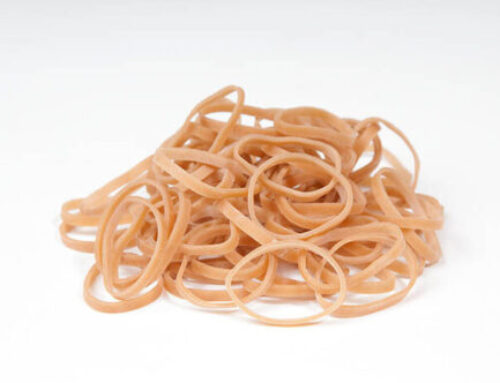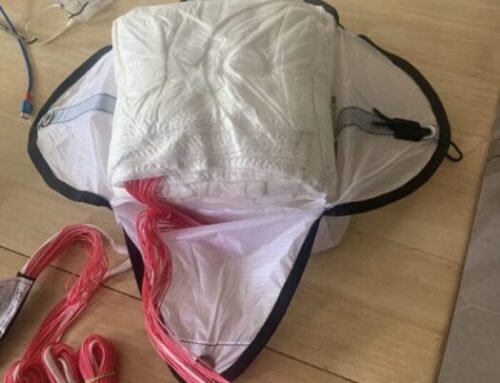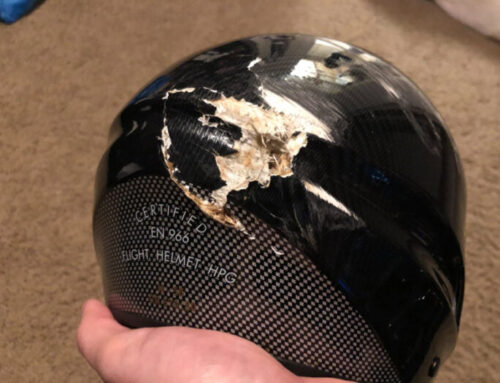ATTACHING THE RESCUE BRIDLE TO THE HARNESS WEBBING
You can use one of three different connection methods for connecting paragliding reserve parachute to the harness. We recommend that you follow the manufacturers recommendations, and post this as information only. We will discuss the different connections you can use when repacking or changing your reserve in this article.
Maillions
The industry standard for mallions used in paragliding is Peguet Maillon Rapide. Use only stainless steel. We don’t use Zinc or galvanized mallions due to lower strengths.

What size & shape maillion
By measuring the width of the bridal being connected to the maillion, you can determine the best maillon shape. Measure both sides of each connection to get the right style of maillon. A delta or oval shape might be a better fit then a square.
You should rate a properly sized maillon at least 9 times the maximum weight. Use a mallion of at least 2400 DaN to connect the reserve lines to harness lines. To prevent the bridal from slipping around and cross loading the maillon during a reserve deployment. Be sure to stablize the maillon connection by using rubber O rings or similar.
We don’t use sticky tape to stabilize the mallions, because tape can leave an adhesive residue on the webbing that may potentially affect the strength of the bridle. Self-fusing silicone tape has no adhesive and seems to work well.
You must take care to properly screw closed the maillion. Finger tight is not adequate to keep them from opening. Using a small wrench, the barrel nut should be tightened approximately 1/8 – 1/4 turn after seating the barrel finger tight. Be careful not to damage the threads by over-tightening them. Please refer to the Pequet link below, for exact torque specifications.
Pequet provides this chart for proper torque specifications.
Connecting the harness bridal to the reserve bridal (one connection point)
We suggest you follow recommendations of some of the most trusted harness and reserve manufactures. Install a 7 MM square mallion for single point Paragliding Reserve Connections.
If you’re using a standard (oval) 6 MM maillion. Due to its increased strength, it can replace a 7 MM square mallion.
Some recommendations from owner’s manuals
- Gin Genie Lite manual recommends; a 7 MM maillon rated 3125 KG
- Gin Genie lite 3 manual recommends; The English manual says 6MM but the DE. & FR. manual both recommend 7MM. All three state 12.5 kN (1274.64 kgf)
- Gin Genie Gingo Airlite4 manual recommends: a 7 MM Square maillon rated to 28 kN (2855 KG)
- Advance Progress 3 manual recommends: a maillon with a minimum breaking load of 2400 daN (2,447 KG)
- Supair Acro 4 manual recommends: a 7 mm stainless steel maillon.
- Woody Valley X Alps manual recommends: 2400 KG and 1200KG for shoulder connection points.
- Supair Fluid Light Evo manual recommends: 7 MM for single point & 6 MM for shoulder connection points.
Calculator for Kilonewtons (kN) to Kilograms (kg)
Pequet Maillion Breaking Loads
5 MM Stainless Steel Square 750 KG 5 MM Stainless Steel Standard (oval)1400 KG 5 MM Stainless Steel Trapeze & Delta 1625 KG
6 MM Stainless Steel Square 1250 KG 6 MM Stainless Steel Standard (oval) 2000 KG 6 MM Stainless Steel Trapeze & Delta 2250 KG
7 MM Stainless Steel Square 2000 KG 7 MM Stainless Steel Standard (oval) 2750 KG
Connecting to two connection points
When making paragliding reserve Connections that are two separate connections, 6 MM Square maillions can be used. For example, as you would if your harness doesn’t have built in bridals already connected at the shoulder points but provides reinforced left and right-side shoulder loop connections at the top of the harness designed to connect a reserve. You should also use O rings or similar to secure the attachment and prevent excess friction.
Web to web or looped.

If specifically recommended by the harness and reserve manufacturer you can use a looped connection. To eliminate friction during a deployment, you must secure these connections to keep them tight.
From Advance’s manual, “ADVANCE carried out an exhaustive series of tests in 2017 to investigate the strength of the direct loop-in-loop method of connecting these two webbing items. This involved a series of material combinations of harness V-lines and reserve bridles; such are as used in ADVANCE harnesses with COMPANION reserves. Compared with a Maillon Rapide connection the strength of this arrangement was slightly reduced, but not to an extent that would compromise its function.
For this reason, the direct looping of ADVANCE products is reliable and safe, provided certain basic precautionary measures are observed, such as the centering of the connection position on both loops, and then pulling the line junction as tight as possible. We cannot make a definitive statement about the strength of such a connection of ADVANCE harnesses with other reserves.”
Front mounted reserves
If your harness has no shoulder connection points built into the harness or you’re flying with second front mounted reserve. You’ll need to connect your reserve to the main connections used for your wing. One option is to connect the reserve bridles directly onto the main carabiners. For extra security should a carabiner fail, connect using soft links passed through the main attachment points on the harness. Disadvantages of this connection is managing a procedure to unclip & reclip one side of the reserve to get in or out of the harness.
Soft links
A soft shackle replaces a steel maillon, and can be used for webbing-to-webbing connections, between your rescue and Y-bridle. Compared to a 6 mm steel maillon, the GIN Soft shackle is up to 8 times lighter with equivalent or greater breaking strength.
It features a locking system to prevent slippage under load and is easy to undo without tools. Follow the manufacturer’s instructions carefully to ensure you close them properly, if not connected correctly the Soft Shackle may fail.
They are probably best used where they can remain connected and don’t need to be removed before or after each flight.

GIN Soft Shackle diagram





